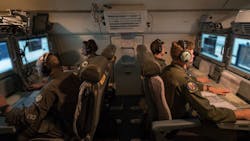Detection and imaging of moving ground targets with synthetic aperture radar (SAR) is aim of MTR project
ARLINGTON, Va. – U.S. military researchers are approaching industry to develop algorithms and collection techniques to enable synthetic aperture radar (SAR) sensors to detect, geolocate, and image moving ground targets.
Officials of the U.S. Defense Advanced Research Projects Agency (DARPA) in Arlington, Va., issued a solicitation earlier this month (HR001120S0057) for the Moving Target Recognition (MTR) project.
Researchers are emphasizing military vehicle targets, including slow-moving vehicles whose SAR signatures are superimposed on clutter. If the project succeeds at moving target detection, geolocation, and imaging, MTR will start developing ATR algorithms for moving target images.
MTR will include airborne data collection experiments to test and evaluate algorithms to detect moving ground targets. Performers will be responsible for the airborne radar sensors and flight services, while DARPA will handle designing experiments that involve moving ground vehicles, instrumented to provide ground truth.
Related: L-3 to develop imaging radar prototype to give AC-130 gunship more punch in bad weather
The MTR program is part of the DARPA Mosaic Warfare vision, which seeks to create rapidly reconfigurable military forces that are fast, unpredictable, flexible, and adaptable -- more like the pieces in a mosaic piece of art, rather than a collection of rigidly designed pieces of a puzzle.
The MTR program has two phases: a two-year effort that focuses on locating moving targets, as well as detection and imaging; and automatic target recognition (ATR) of the moving target images. This solicitation concerns only phase-one. Several contracts are expected.
Companies interested should respond no later than 15 Sept. 2020. Confidential and secret responses may be hand-carried by authorized courier, or by U.S. Postal Service registered mail or express mail to DARPA/STO, ATTN: HR001120S0057, 675 North Randolph St., Arlington, VA 22203-2114.
Email questions or concerns to DARPA at [email protected]. More information is online at https://beta.sam.gov/opp/fc329b5a1f8242a7b145e7f36d9eae65/view.
About the Author
John Keller
Editor-in-Chief
John Keller is the Editor-in-Chief, Military & Aerospace Electronics Magazine--provides extensive coverage and analysis of enabling electronics and optoelectronic technologies in military, space and commercial aviation applications. John has been a member of the Military & Aerospace Electronics staff since 1989 and chief editor since 1995.
